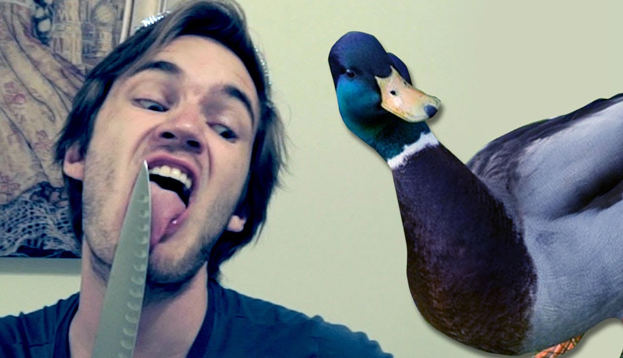by Jessica Klein
As someone who creates video game content for YouTube, Felix Kjellberg, better known as PewDiePie, faces particular challenges and embraces genre-specific strategies when it comes to his content. He told Rhett & Link about some of them on this, the one-year anniversary day of the duo’s podcast, “Ear Biscuits.”
To begin with, Kjellberg has to maintain a running commentary throughout the entire time he plays a game in his “Let’s Play” videos… or, at least, he seems to. “I usually shoot like an hour and maybe I’m active 20 minutes of it,” Kjellberg explained of how he manages the effect of constant dialogue, which, of course, can get tiring. However, at other times, the comedic gamer manages a steady ten minutes straight of entertaining talk while he plays. “It depends on the game,” he explained.
Either way, this requires “almost a radio DJ kind of aptitude,” Rhett noted, and Kjellberg agreed, explaining that he’s usually a “pretty chill guy” (which you can tell from his presence on “Ear Biscuits”). He has to put on a more energetic, crazier persona for his videos, but who doesn’t
This alone doesn’t explain the man’s ridiculous level of success on YouTube, success that ranks him as the number one individual creator in terms of subscribers at over 31.3 million. So what’s made the “comedian gamer,” which he suggested as his title, so popular in the genre
“Consistency,” for one, and also doing his own thing helped Kjellberg pick up subscribers left and right. While most other gamers on YouTube did “the same old, boring stuff” in Kjellberg’s earlier days on the platform (read: making Let’s Play videos with “Call of Duty”), Kjellberg came up with his now famous horror montages and took a markedly comedic angle with his running commentary. Also, Kjellberg had a unique strategy in terms of picking games to play for viewers online.
He chose the games that were “stupid,” because, as he noted, “Bad games make for funnier videos.” This piece of wisdom eventually led Kjellberg to “Happy Wheels,” which his fans were none too happy about, at first, since he’d departed with the horror game genre they’d come to love and expect. Fans on YouTube don’t always take well to change when it comes to their favorite creators, but Kjellberg’s fresh content ended up winning viewers over in the long run. “So you shouldn’t always listen to what they say,” he cautioned.
While many creators then go on to create new channels, designated to each particular variety of content they make, Kjellberg stuck to his original YouTube home. He believes this helped him rack up such impressive subscriber numbers, because he “does everything in one,” driving a higher volume of views to a single place on the video platform rather than spreading them around.
Also, Kjellberg had to thank YouTube in part for his major success. He’s been featured on the platform plenty, and he never had to alter his channel much since it started growing. “I feel like I was riding a freeway from YouTube,” he described. “YouTube must be helping somehow.”
Mostly, Kjellberg should thank his own efforts. “I would say that the consistency that I had, people really respond to that, having a close connection with my fans, which I had from the beginning, doing something unique, which kind of lifted me up from this huge market of gamers, and being a unique persona—that’s all it takes,” he said.
Well, that can’t quite be all it takes, and Kjellberg elaborated in the one-year anniversary episode of “Ear Biscuits with Rhett & Link.”

